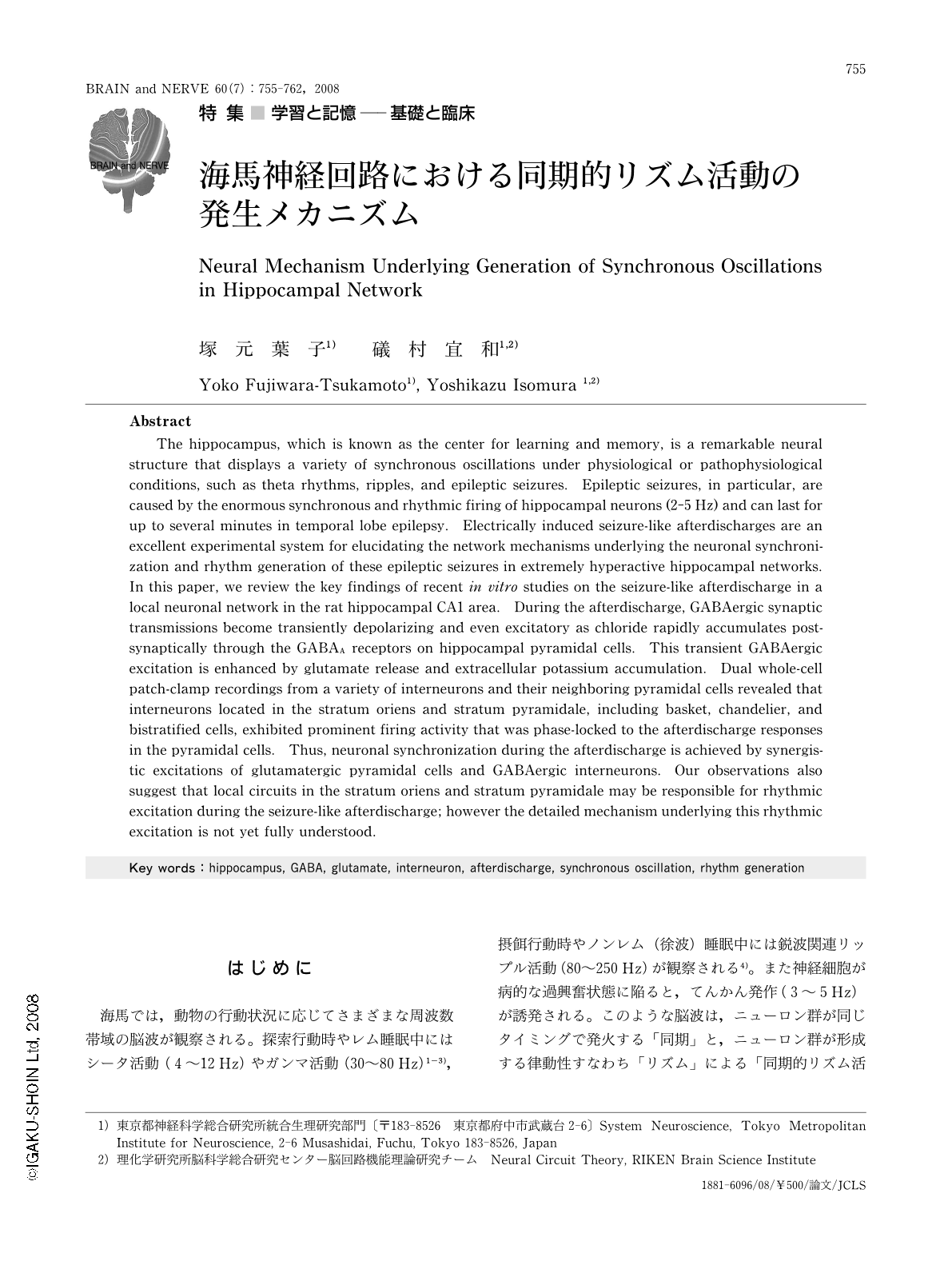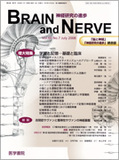Japanese
English
- 有料閲覧
- Abstract 文献概要
- 1ページ目 Look Inside
- 参考文献 Reference
はじめに
海馬では,動物の行動状況に応じてさまざまな周波数帯域の脳波が観察される。探索行動時やレム睡眠中にはシータ活動(4~12Hz)やガンマ活動(30~80Hz)1-3),摂じ行動時やノンレム(徐波)睡眠中には鋭波関連リップル活動(80~250Hz)が観察される4)。また神経細胞が病的な過興奮状態に陥ると,てんかん発作(3~5Hz)が誘発される。このような脳波は,ニューロン群が同じタイミングで発火する「同期」と,ニューロン群が形成する律動性すなわち「リズム」による「同期的リズム活動」の反映と考えられる。この同期的リズム活動が動物の行動や脳の状態と密接に連関するという事実は,多数の神経細胞が一斉に律動的に活動することが脳神経回路の基本的な性質であり,これが脳機能の円滑な遂行に重要な役割を果たすことを示唆している。例えば,記憶のシナプスメカニズムのin vitroモデルである海馬LTP(長期増強)がシータ帯域の周波数を利用した刺激により効率的に惹起される5)ことなどからも,記憶・学習のメカニズムにおける同期的リズム活動の生理学的意義が推測できる。また,in vivo自由行動動物において,海馬のリズム活動が空間認知や記憶に本質的に関与していることも,最近明らかにされてきている2,6)。
この「同期」と「リズム」の生成機構を細胞レベルまたは神経回路レベルで解明する試みとして,海馬スライス標本において同様の現象を再現するin vitro実験モデルがいくつか開発されてきた。まず,細胞外イオン環境の操作や薬理学的な処理によって同期的リズム活動を誘発するモデルとして,スライスの長時間低Ca処理7,8),長時間低Mg処理9,10),高K処理11),Kチャネル阻害12),GABAA受容体遮断13),ムスカリン受容体刺激14)などが挙げられる。いずれのモデルでも同期的で律動的な発火活動を出現させることができるが,スライス標本内の各種神経細胞がどのように同期し,リズム自体がどのように生成されるのか,というメカニズム全容の解明には至っていない。もう1つの実験モデルは,強い電気刺激(テタヌス刺激)によって誘発される発作様後発射(afterdischarge)である15,16)。このモデルは,極端に細胞内外の環境を変えることなく同期的リズム活動を誘発できることから,「てんかん」のin vitroモデルとしても有用であり,実験者の任意のタイミングで再現性高く誘発できる利点を持っている。そのため,ニューロンネットワークが作り出す律動的な活動パターンの細胞レベルでの解析には理想的なモデルといえる。
筆者らは,成熟ラットの海馬CA1単離スライス標本におけるテタヌス誘発性の発作様後発射に注目し,主に錐体細胞と介在細胞の相互作用に焦点を当てて,ニューロンネットワークにおける同期的リズム活動の生成機構を細胞レベルで解析してきた。本稿では,現在までに筆者らが明らかにしてきた研究結果について概説したい。
Abstract
The hippocampus, which is known as the center for learning and memory, is a remarkable neural structure that displays a variety of synchronous oscillations under physiological or pathophysiological conditions, such as theta rhythms, ripples, and epileptic seizures. Epileptic seizures, in particular, are caused by the enormous synchronous and rhythmic firing of hippocampal neurons (2-5 Hz) and can last for up to several minutes in temporal lobe epilepsy. Electrically induced seizure-like afterdischarges are an excellent experimental system for elucidating the network mechanisms underlying the neuronal synchronization and rhythm generation of these epileptic seizures in extremely hyperactive hippocampal networks. In this paper, we review the key findings of recent in vitro studies on the seizure-like afterdischarge in a local neuronal network in the rat hippocampal CA1 area. During the afterdischarge, GABAergic synaptic transmissions become transiently depolarizing and even excitatory as chloride rapidly accumulates postsynaptically through the GABAA receptors on hippocampal pyramidal cells. This transient GABAergic excitation is enhanced by glutamate release and extracellular potassium accumulation. Dual whole-cell patch-clamp recordings from a variety of interneurons and their neighboring pyramidal cells revealed that interneurons located in the stratum oriens and stratum pyramidale, including basket, chandelier, and bistratified cells, exhibited prominent firing activity that was phase-locked to the afterdischarge responses in the pyramidal cells. Thus, neuronal synchronization during the afterdischarge is achieved by synergistic excitations of glutamatergic pyramidal cells and GABAergic interneurons. Our observations also suggest that local circuits in the stratum oriens and stratum pyramidale may be responsible for rhythmic excitation during the seizure-like afterdischarge; however the detailed mechanism underlying this rhythmic excitation is not yet fully understood.

Copyright © 2008, Igaku-Shoin Ltd. All rights reserved.


